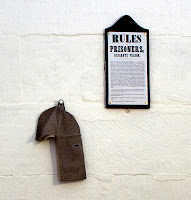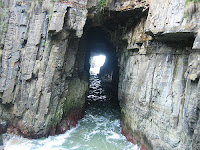 |
| Chain gang - Port Arthur |
 |
| Penetentiary building |
We were in two minds about traveling to Port Arthur because of the sadness of more recent history. However, my interest was sparked when I learnt during a recent discussion with my dad, that a convict relative (not quite sure if it was my great grandfather or great uncle) had worked for a free settler in Tasmania. However dad was unsure if he had done time at Port Arthur. So I had a specific interest in seeing Port Arthur again - last time we were here was 1996 and the memories were still fresh in our minds.
Port Arthur was originally a timber station (1830). However, the 1840s witnessed a consolidation of the industrial and penal nature of the settlement as the convict population reached over 1100. In 1842 the old flour mill and granary (see above) was transformed into a penetentiary. It had 136 single cells but most of the prisoners lived in dormitories on the top level housing 513 prisoners. Although all the timber in the building burned up in a fire in 1897, you can still see a lot of details and imagine a life in a 135cm long cell.
 |
| Separate Prison |
A few years after finishing the Port Arthur Penitentiary, in 1848, the Separate Prison was built, reflecting the new philosophy of building of gaols in England. The 80 cell prison was used to house re - offending prisoners already incarcerated in prisons on the Australian mainland, and was considered to be the harshest prison in Australia at that time.
 |
| Anomity mask & rules |
Prsioners were called by numbers instead of their names, they were denied speech, they wore head masks while in the exercise yard, and while in the church they’d be separated in different boxes.
A separate Boys Prison was established at Point Puer (1834 - 49) on the sea-edge of Port Arthur for 'little depraved felons'. It was the first British purpose-built reforming institution for criminal boys.
 |
| Point Puer |
Around 3000 children, aged between 8 - 18 were transported to this special purpose-built prison renowned for its harsh discipline.
 |
| Non-demoninational Church |
 |
| Asylum |
The dead from the prison were buried at the nearby Isle of the Dead, where there are 1,646 graves of convicts and guards situated there. Only the graves of the prison guards are marked.
Is it any wonder that many of the prisoners in the Separate Prison developed mental illness? An asylum was built next to the model prison in 1864 to house mentally ill patients. It is extraordinary to contemplate that 12 500 convicts served their time at Port Arthur between 1830 and 1877. And yes, I did find a relative more research is needed but it seems to match up with what I now know James Peters convict #55920 who arrived on the Waterloo (1) voyage 122 on the 03 Mar 1835.
Port Arthur Historic Site is an important part of Australian history, although somewhat horrific. Rob and I thank the staff and locals for the condition it is kept. We admire and respect the silence maintained in regard to a more recent tragedy. Quiet observance is best, and as you leave Port Arthur, you feel respect for those who survived, and remember those who didn't.
There is so much more to Port Arthur the coastline is spectacular. A short drive south of Port Arthur will take you to Remarkable Cave, a cave-like opening that leads out to sea. From here you can walk to Crescent Bay, a secluded curve of striking beauty backed by huge sand dunes. A big thank you to Lee and Steve for their warm hospitality and a night of wild entertainment :))
Port Arthur Historic Site is an important part of Australian history, although somewhat horrific. Rob and I thank the staff and locals for the condition it is kept. We admire and respect the silence maintained in regard to a more recent tragedy. Quiet observance is best, and as you leave Port Arthur, you feel respect for those who survived, and remember those who didn't.
 |
| Remarkable Cave |
No comments:
Post a Comment